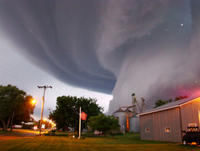-
Killer silk kills anthrax, other microbes dead
A simple, inexpensive dip-and-dry treatment can convert ordinary silk into a fabric that kills disease-causing bacteria — even the armor-coated spores of microbes like anthrax — in minutes
-
-
Japanese military buys biowarfare detectors
The U.S. military deploy the Joint Biological Point Detection System (JBPDS), and the Japanese military want to do the same, awarding a North Carolina company a $9 million contract
-
-
The bioterrorism threat and laboratory security

Leonard A. Cole, an expert on bioterrorism and on terror medicine who teaches at Rutgers University, investigates the security of U.S. high containment labs in light of the dramatic growth in the number of these labs, which handle dangerous pathogens, following 9/11 and the anthrax attacks
-
-
Balancing safety, risk in the debate over the new H5N1 viruses
This fall, the U.S. National Science Advisory Board for Biosecurity (NSABB) set off a debate when it asked the authors of two recent H5N1 research studies and the scientific journals that planned to publish them to withhold important details of the research in the interest of biosecurity; the scientific community is divided over the issue of best to balance free research and security
-
-
Public health expert: budget cuts will erode response capabilities
Homeland Security NewsWire’s executive editor Eugene K. Chow recently got the opportunity to speak with Dr. John R. Finnegan, the dean of the University of Minnesota School of Public Health; in their interview, Dr. Finnegan discusses the devastating effects of proposed budget cuts on the U.S. public health system, why it was a wise decision to censor the release of H5N1 flu research; and the creation of a medical reserve corps at universities
-
-
Anthrax-decontamination foam used in meth lab cleanup
The meth cleanup problem in the United States is a big one; the U.S. Drug Enforcement Administration lists thousands of locations where law enforcement agencies have found chemicals or paraphernalia indicating the presence of either clandestine drug laboratories or dumpsites; Sandia’s decontamination foam, originally developed to deal with anthrax, is now also a meth eraser
-
-
Thwarting the botulinum neurotoxin
The botulinum neurotoxin is the most poisonous substance known to man, causing botulism; it can be used by terrorists for deadly attacks; the toxin paralyzes muscle cells by disrupting their connections with the nerves that tell them how and when to move
-
-
Kansas biolab project on life support

In 2008, DHS chose Manhattan, Kansas, as the location for a new, $650 million BioLab Level 4; the new lab was planned as a replacement for the aging Plum Island facility; critics argued that the lab’s location — in the middle of Tornado Alley and at the center a region which is home to a large portion of the U.S. beef industry – was not ideal for a facility doing research on deadly animal and human pathogens; it now appears that budgetary considerations have doomed to project
-
-
A bioterrorism threat for the birds?

In his first guest column, Leonard A. Cole, an expert on bioterrorism and on terror medicine who teaches at Rutgers University, explores the recent controversy over bird flu research, its implications on national security, and why efforts to curb information regarding the research will likely have limited success
-
-
Scientists urge accelerated flu research
The discovery by scientists that H5N1 virus could potentially be transmitted between mammals has led to fears both of misuse and of accidental release – and to requests of two leading science publication to edit and redact portions of two articles in which the findings of the research are reported; a leading specialist argues that H5N1 viruses circulating in nature may already pose a threat because influenza viruses constantly mutate and can cause pandemics
-
-
Federal court hears debate over California bio weapons research facility

Earlier this month opponents of the bioweapons research center at Lawrence Livermore National Laboratory argued before a federal appeals court that government officials failed to heed a 2006 court ruling and recklessly went ahead with the research facility without considering terrorist threats
-
-
Kansas State takes over pathogen research from Plum Island
As New York’s Plum Island Animal Disease Center begins to shut down, much of its pathogen work will be transferred to Kansas State University’s Biosecurity Research Institute in preparation for the opening of DHS’ new National Bio and Agro-Defense Facility (NBAF) in nearby Manhattan, Kansas
-
-
Delicate balance: scientific freedom and national security
Two legal scholars argue that the U.S. government’s request that the journals Science and Nature withhold scientific information related to the genetically modified H5N1 virus because of biosecurity concerns does not violate the First Amendment
-
-
Chicago's new bio-attack response facility

Chicago is preparing itself for a biological attack with the recent unveiling of a new 40,000 square-foot, fourteen story state-of the-art medical decontamination facility; the new facility is fully equipped to handle a sudden influx of patients from a biological attack or other mass casualty incident
-
-
Budget cuts hamper U.S. response to biological attack
A recently released report charges that state and federal budget cuts have weakened U.S. bioterrorism response capabilities
-
- All
- Regional
- Water
- Biometrics
- Borders/Immig
- Business
- Cybersecurity
- Detection
- Disasters
- Government
- Infrastructure
- International
- Public health
- Public Safety
- Communication interoperabillity
- Emergency services
- Emergency medical services
- Fire
- First response
- IEDs
- Law Enforcement
- Law Enforcement Technology
- Military technology
- Nonlethal weapons
- Nuclear weapons
- Personal protection equipment
- Police
- Notification /alert systems
- Situational awareness
- Weapons systems
- Sci-Tech
- Sector Reports
- Surveillance
- Transportation
Advertising & Marketing: advertise@newswirepubs.com
Editorial: editor@newswirepubs.com
General: info@newswirepubs.com
2010-2011 © News Wire Publications, LLC News Wire Publications, LLC
220 Old Country Road | Suite 200 | Mineola | New York | 11501
Permissions and Policies
Editorial: editor@newswirepubs.com
General: info@newswirepubs.com
2010-2011 © News Wire Publications, LLC News Wire Publications, LLC
220 Old Country Road | Suite 200 | Mineola | New York | 11501
Permissions and Policies
